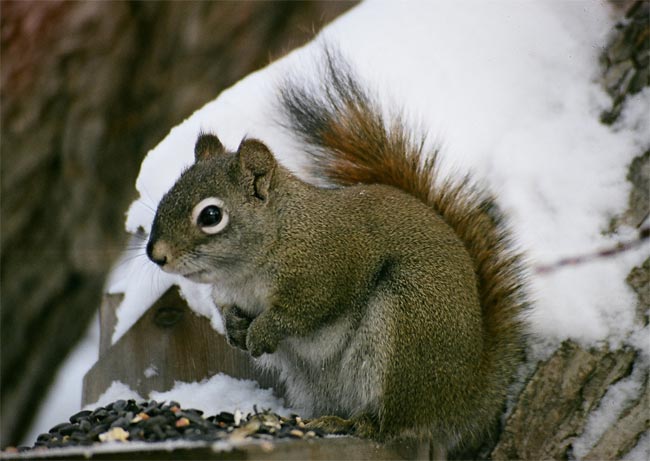Savvy Squirrels Outwit Trees

Like good stock brokers, red squirrels predict when the market will be flooded with seeds and then invest big by producing a second litter of young, a new study finds.
"Lots of animals time their reproduction to match predictable increases in resources like the new growth of plants every spring," said lead researcher Stan Boutin of the University of Alberta. "But the interesting twist here is that these squirrels have figured out a way to produce this second litter of babies at a time when they have little food and before an ‘unpredictable’ boom in seed production.”
The results are detailed in the Dec. 22 issue of the journal Science.
Seed market
Unlike Eurasian red squirrels, which feed on a variety of pine-tree seeds, American red squirrels dine almost exclusively on the seeds hidden in spruce-tree cones. Before the seeds are ripe, the furry mammals clip the cones from tree limbs and bury them in one spot underground.
If successful with their hoarding and gorging, the squirrels could wreak havoc on trees whose sole way of reproducing is through seed dispersal.
The trees have devised a strategy, however, to protect at least some of their seeds. From one year to the next, they unpredictably produce either an overabundance of seed-bursting cones or just a few. For instance, one year the trees are covered with more than 1,000 cones each, while the next year just tens of cones dangle from tree limbs.
Sign up for the Live Science daily newsletter now
Get the world’s most fascinating discoveries delivered straight to your inbox.
Scientists think the “swamp and starve” strategy works like this: With few resources during bust seasons, squirrels will starve so that in booming conditions there will be few seed-eaters to scarf down the windfall. Once the cones develop on a tree it’s too late for the squirrels to reproduce and take advantage of the food. That way more seeds survive to germinate in bountiful years compared with trees that produce a steady amount of seeds each year.
Savvy squirrels
Boutin and his colleagues monitored two species of red squirrels, including a natural population of American red squirrels in southwestern Yukon, Canada from 1987 to 2004, and Eurasian red squirrels in Belgium and Italy.
Somehow the squirrels could anticipate when the trees would be laden with cones, and only during these years they produced a second litter of young. In addition to predicting the future, the squirrels were able to reproduce while females were breast-feeding the first litter—something that doesn't normally occur in mammals, said study team member Andrew McAdam of Michigan State University.
Taste test
While the researchers still aren’t certain how the squirrels can predict the cone market from year to year, they think it might be some chemical or visual cue from the buds that ultimately form tree cones. Every summer the squirrels nibble on these buds. "Squirrels could be using a visual cue or a hormonal cue they gain from eating the buds," Boutin said.
Or perhaps the squirrels are deciphering a code used each year by the trees to synchronize their cone production.
The trees, McAdam said, might be using large-scale weather patterns to orchestrate whether it’s a swamp or starve year. “It’s possible that the squirrels have somehow decoded the message that the trees have been using to coordinate themselves and they’re using that as their cue,” McAdam told LiveScience.
- Mating Game: The Really Wild Kingdom
- The Weirdest Science Stories of 2006
- Top 10 Species Success Stories
- Amazing Animal Abilities
Jeanna Bryner is managing editor of Scientific American. Previously she was editor in chief of Live Science and, prior to that, an editor at Scholastic's Science World magazine. Bryner has an English degree from Salisbury University, a master's degree in biogeochemistry and environmental sciences from the University of Maryland and a graduate science journalism degree from New York University. She has worked as a biologist in Florida, where she monitored wetlands and did field surveys for endangered species, including the gorgeous Florida Scrub Jay. She also received an ocean sciences journalism fellowship from the Woods Hole Oceanographic Institution. She is a firm believer that science is for everyone and that just about everything can be viewed through the lens of science.









